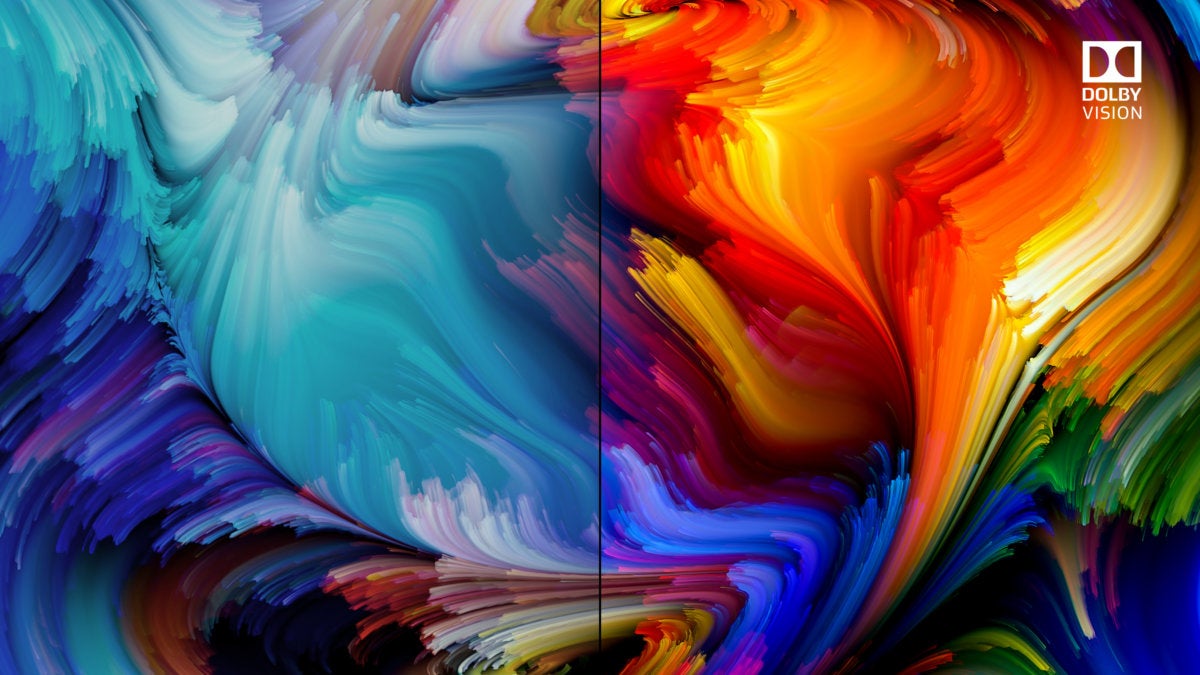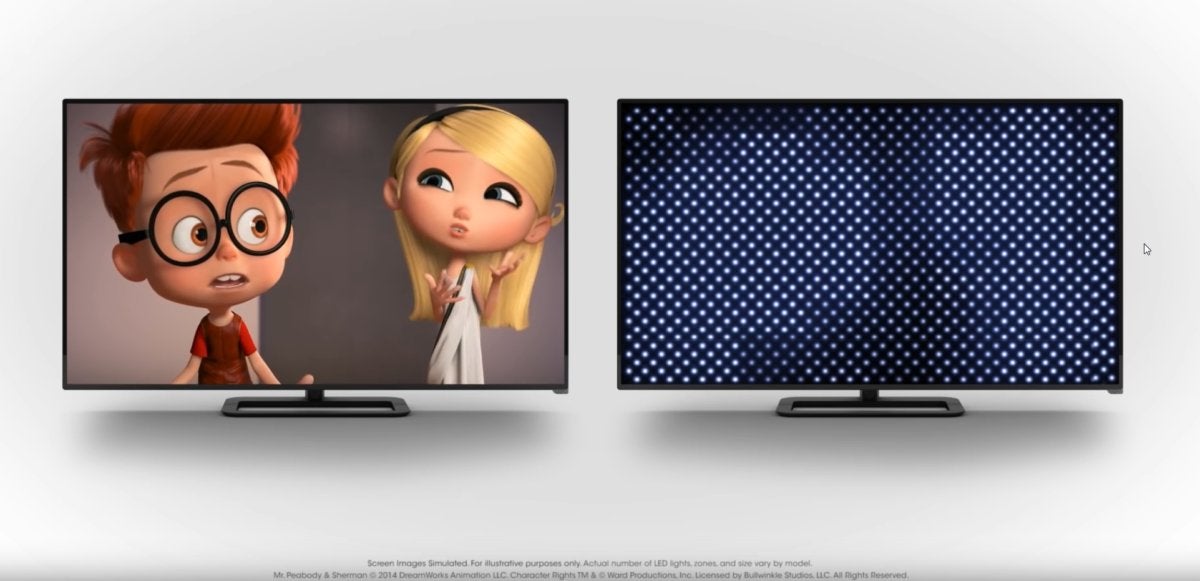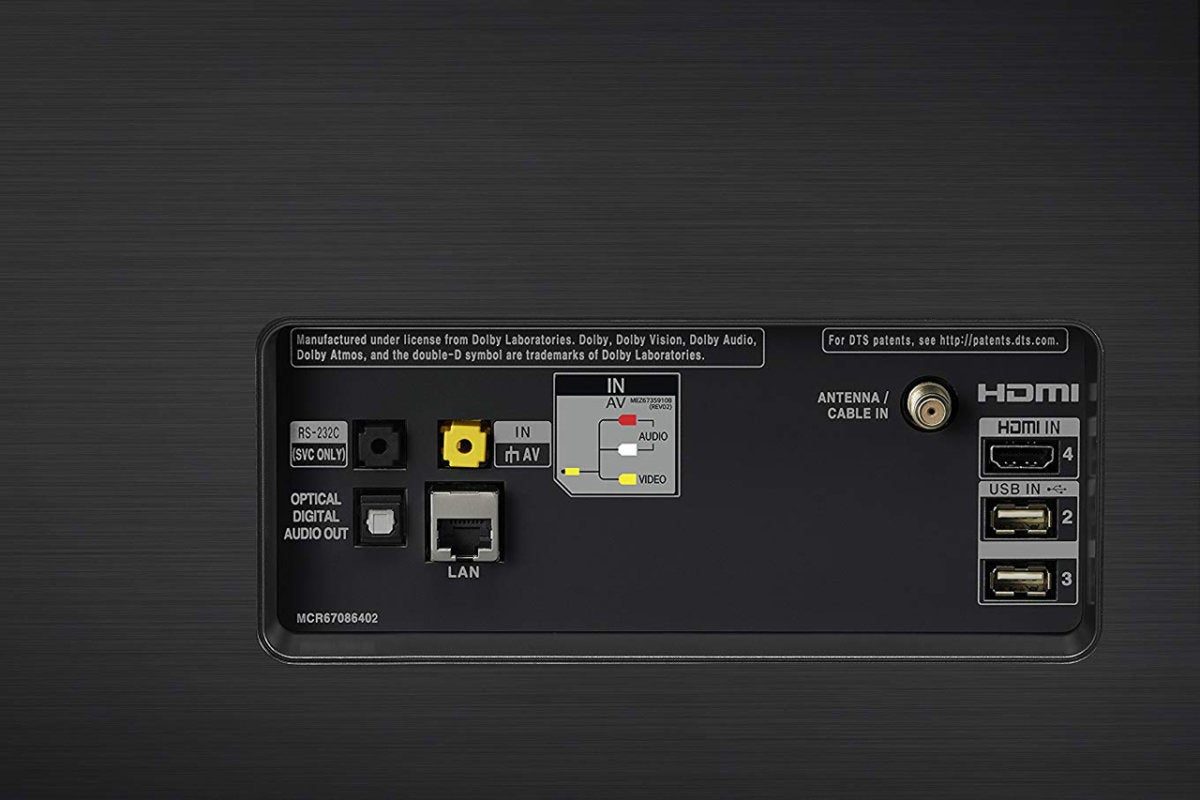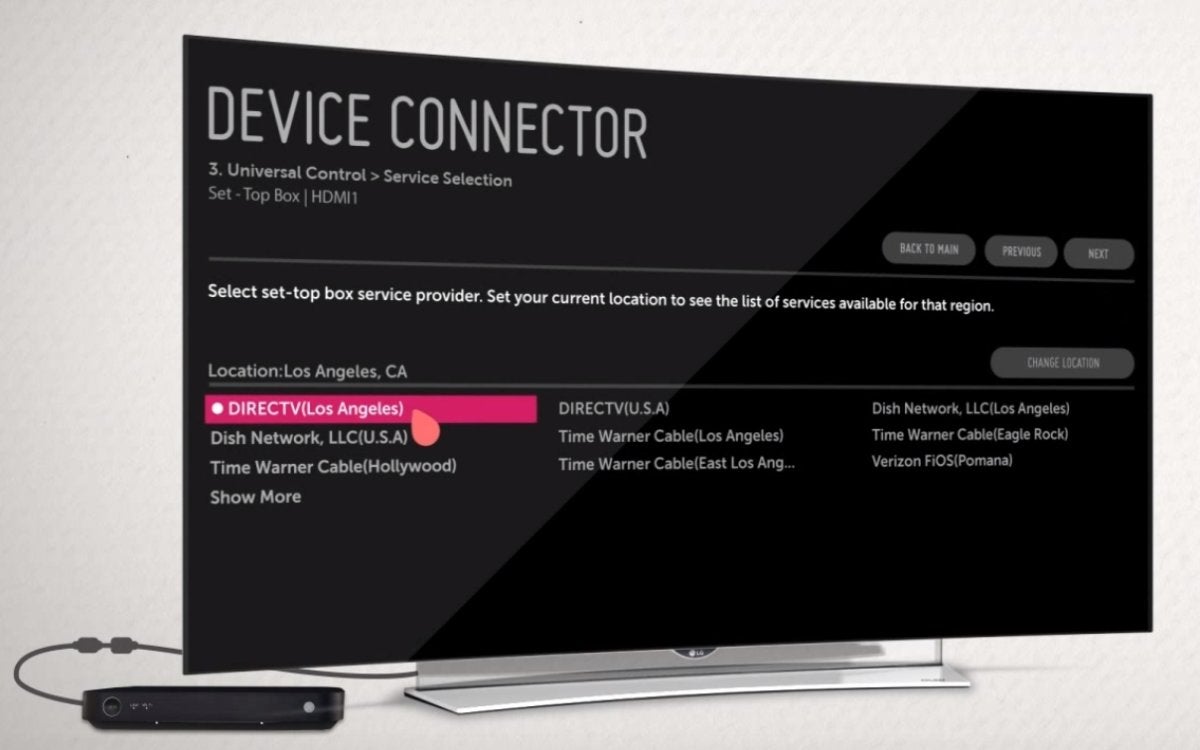Best Tv With Deep Black Picture 2018 Review
There's never been a meliorate fourth dimension to buy a TV. Yeah, we said the aforementioned a couple of years ago, just that doesn't brand it any less true The manufacture has worked nearly all of the bugs out of LCD and OLED TVs, and today's prices are lower than ever. Or they were until this contempo chip shortage took hold.
Regardless, loftier-finish 4K models cost nearly half of what they did a few years agone, and excellent mid-range models (55- and 65-inch grade) are available for much less than $1,000. Nosotros'll requite you lot our top picks, plus an in-depth guide to the specs and features you'll encounter when you lot shop.
A different language
The get-go hurdle to understanding today's Idiot box market is an alphabet soup of acronyms and phraseology: LED, mini-LED, micro-LED, LCD, HDR, OLED, breakthrough dots, and more. Manufacturers also like to thicken that literary goop with their own trademarked, mostly nonsensical nomenclature: Dissimilarity EliteMax, Q Way Elite, X-tended Dynamic Range PRO? Give me a suspension.
The skilful news? You lot can ignore all that advert-speak and focus on simply three things: colour, dissimilarity (including the quality of blacks), and effulgence. Engineering science changes, but your eyes don't.
Hither are our elevation recommendations in three categories. If you want a deeper agreement every bit to why nosotros picked them, at that place'south an in-depth buyers' guide further downwardly that you'll observe invaluable when you go shopping.
Updated April 15, 2022 to add a link to our Vizio P85QX-J01 smart Tv set review. This 85-inch model delivers an incredible amount of brightness–Vizio claims 3,000 nits–and it delivers the wow with HDR content. Nosotros were slightly less impressed with its image-processing chops, detecting some artifacts and other issues with our punishing criterion content.
Best LCD Boob tube
Samsung combines a micro-LED backlight with quantum-dot engineering science to deliver the best LED-backlit LCD Television you tin buy. OLED TVs still deliver better blacks, but while this Tv set isn't inexpensive, its toll tag is nowhere nearly what you'd pay for a loftier-end OLED set. Nosotros have a few nits to pick in our review, but this TV is like shooting fish in a barrel to recommend.
All-time OLED TV
LG no longer makes our favorite OLED Telly, Sony has stolen its crown with its Bravia XR Master Serial A90J. This smart TV produces an absolutely luscious pic, and information technology features Sony's adventurous audio arrangement in which the driver units are mounted to the OLED console itself, turning the unabridged display into a speaker. The Google Tv operating system makes finding neat entertainment a snap, and its universal remote is backlit and easy to utilize, even in the nighttime. This one will exist tough to trounce.
Runner-upwardly
We'll take to wait and run across if LG tin recapture the title "Best OLED Goggle box," but for more than $750 less than Sony's best OLED, LG easily takes the runner-upwardly spot with its affordable—for an OLED, at to the lowest degree—C1-series 4K OLED.
All-time bang-for-the-buck TV
TCL is rapidly gaining—and deserving—a reputation for building affordable smart TVs that deliver incredible value. Information technology's 55-inch 6-serial is certainly no exception, combining breakthrough-dot color with mini-LED backlight technology to build a prepare with great color, brightness, and the Roku Television set operating arrangement. Nosotros similar information technology a lot.
Best value in 8K TVs
You can spend a lot of money for an 8K Idiot box, or you can spenda lotof money on an 8K Idiot box. TCL'southward 8K offering is an incredible value for the quality and performance that'due south delivered for the price. If you don't need to have the absolute all-time in the 8K category, the TCL 65R648 is a fantastic deal.
The state of TV technology
CRT TVs were around for more 50 years and were still being improved when they barbarous out of favor. LCD TVs aren't nigh that mature, and you'll however discover the occasional entry-level models with color and contrast problems. Colour and dissimilarity have all the same improved drastically in the final few years, and the improvements have trickled down most to the lowest rung on the ladder. OLED remains at the height, only remains expensive to industry. I'll talk more about LED versus OLED in a bit.
There's also a resolution "race" in progress, though it seems to take stalled for the nonce at 8K UHD. Buying a TV with resolution of 7680 x 4320 pixels remains a pricey proposition, and there's well-nigh no content to accept advantage of it. Apart from 4K Blu-ray, most video content is still delivered in 1080p resolution, fifty-fifty though 4K UHD TVs with resolution of 3840 x 2160 pixels rule the roost in terms of sales.
The best news, to expand on my previous point, is that top-end technology (quantum dots, mini-LED) has filtered down to the mid-range (divers as $750 to $i,250 for a 65-inch-form set). We haven't seen one that quite puts it all together yet, but TCL's half dozen-serial come darn close. Too close, certainly, for the large three (LG, Samsung, and Sony) to remain comfy.
Fifty-fifty better, nearly all the high-terminate 4k UHD 65-inch-class TVs that price $600 to $ten,000 or more a few years ago take dropped to below $3,000. Even Samsung's 8K UHD QN800A-series can exist hand for $3,500 (65-inch form). LG's 8K UHD OLED—the 88-inch-class model OLED88Z9PUA—is something to behold, simply it costs $thirty,000. Ouch. Then again, if your entertainment center is big enough to require an 88- to 120-inch-class telly, that price tag might worth the experience.
What to look for (and what to watch out for)
Resolution: While nigh content remains 1080p or lower resolution, the vast majority of TVs being sold now are 2160p (4K UHD, or 3840 x 2160 pixels). Unless you're buying something for the workshop or tool shed, go 2160p. 4K streaming is now a thing. It's heavily compressed, and information technology may run you over your data cap in short order, only it's nonetheless a consideration.
Expert 2160p content looks spectacular, and most 2160p TVs volition upscale lower-resolution content quite nicely. Only don't believe any hokum about making 1080p content wait similar 18-carat 4K UHD.
That said, we've been incredibly impressed with just how much ameliorate both 1080p and 2160p cloth looks on the latest 8K UHD (7680 x 4320) TVs. More pixels, more processing ability.
FAUX K: LG makes spectacular OLEDs, and it seems the company has finally ceased manufacturing the two.88K LED-backlit LCD TVs it marketed as 4K; specifically, the 6300 and 6500 series. So this is only an FYI in case yous see a used or refurbished on for sale: You can avert it, or you can use that data to haggle for a improve price. You tin read more almost the bailiwick in this article. They're not bad TVs, they just aren't 4K UHD.
Screen size: 65-inch TVs are the hot commodity these days, but merely you lot know which size Tv fits all-time in your living space. Personally, I adopt 43-inchers. Go figure.
You tin save a lot of money—$600 to $900 on a top-of-the-line set—by downsizing to perhaps 55-inches and sitting a bit closer. How close? 1.v times the stated size of the Television is the recommended altitude.
Notation that the number of backlighting zones and other technologies aren't always exactly the aforementioned across all sizes. Read the fine impress advisedly (if information technology even exists), as a 55-inch unit might non offer quite the performance of the 65-inch sets companies like to send to reviewers.
HDR: The acronym stands for loftier dynamic range, and it has become the norm in meliorate TVs. HDR but means a larger difference in luminance betwixt the darkest expanse of an image and the brightest expanse. It doesn't audio like much, but a lack of contrast (a comparative washed-out appearance) in LED TVs has long been an issue, especially at the entry level.
With HDR, which is created largely by significantly increasing acme brightness, lite sabers and flames, highlights in hair, water, and other details actually stand out. Trust me. You lot want information technology.

Dolby Vision HDR versus standard dynamic range. All HDR will be similar, but only Dolby Vision and HDR10+ adjust the Idiot box in real time over the grade of the moving-picture show.
So far, the Boob tube industry has been scrupulously honest about labeling their TVs for HDR: HDR-compatible in the fine print ways the set understands at least some of the HDR formats (HDR10, Dolby Vision, HDR10+, HLG, etc.), but likely doesn't have enough brightness to exercise anything with it. If information technology just says HDR, that means it can do something with it.
How much it can exercise depends on the TV. You need at least 700 nits top brightness at a minimum to reach decent HDR pop (e.k., light sabers and flames that stand out), while ane,000 nits does the play a joke on quite nicely. Vendors don't really list nits or brightness in meaningful ways, so you'll demand to read reviews in which it's measured. Non-HDR TVs generally max out in the area of 300 to 400 nits.
HDR format support: One of true ironies in the Tv set industry is that arguably the elevation histrion, Samsung, doesn't back up Dolby Vision. Nearly well-nigh all the other vendors practice (although non on every model). All HDR TVs support HDR10 as a baseline, but HDR10 but sends adjustment info to the Television receiver once, at the beginning of a movie. Dolby Vision and HDR10+ relay it continuously throughout the movie, so each scene (each frame, if necessary) tin can be adjusted independently.
HDR10 looks good. Dolby Vision and HDR10+ look better. HDR10+ is Samsung's baby and its latest TVs support information technology. Alas, while many streaming services deliver HDR in HDR10+ (HDR requires very niggling extra information), it hasn't defenseless on with most of the company's competitors. On the other manus, many sets support the HLG standard that is mutual in Europe.
Contrast:Contrast is the distance in terms of luminance betwixt the darkest and brightest points in an image. Part of HDR is also increasing contrast. A loftier-contrast TV is an HDR Boob tube, although nosotros've never heard of one chosen that. It just doesn't sound sexy, I suppose. Anyway, he higher the contrast, the more than subtle detail the TV tin deliver.
Color: We've noticed a definite uptick in color acuity (realism), fifty-fifty in the center of the marketplace, with TVs from Hisense, TCL and Vizio showing much truer reds and greens (merely about any TV will practice bluish well). This is largely due to the widespread adoption of quantum dots, merely fifty-fifty those without them (Sony's TVs, in particular) have increased the colour vigil of their offeringss.
LED-backlit LCD versus OLED: At that place'south a luxuriousness to the epitome that OLED TVs produce that appeals to many, including myself. Considering each sub-pixel is its own light source, when a pixel is switched off, you go near perfect black. LED-backlit LCD TVs bleed light around and through the LCDs, which are not perfect shutters.
Even the best LED/LCD TVs tin can't match the blacks of OLED. (Mini-LED gets closer—come across below). On the other hand, they can generate much college peak brightness, which compensates with most material and really makes HDR pop.
The main drawbacks of OLED as a technology are a relatively limited lifespan, and burn-in; i.due east. ghosts of previous images remaining on screen. LG claims 100,000 hours to half brightness for its TVs: That's where 500 nits becomes 250 nits, and that number of hours is calculated based on the Goggle box displaying standard dynamic range material. HDR content volition shorten an OLED's lifespan.
With normal use (two hours a mean solar day), those drawbacks will never bite you lot. Or for at least not for a very long fourth dimension. Using OLEDs for signage, all-24-hour interval long viewing, or for rendering static images, on the other paw, is not recommended.
Micro-LED (not to be dislocated with mini-LED backlighting) is a non-organic cocky-emitter technology that doesn't suffer whatsoever of these bug, simply it'southward notwithstanding so expensive as to excuse itself from this conversation.
Caveats and economics bated, OLED remains nigh users' choice when only using their optics. Puppies on velvet!
Annotation: OLED uses an actress white subpixel, but its RGBW is is not the subtractive scheme that LG'south 6300- and 6500-series LED-backlit LCD TVs use. Hence, their stated resolution is accurate.
Viewing angle: While well-nigh TVs look keen when viewed head-on, non all look that neat when viewed from an angle. Then, if you're planning to host Super Basin parties or other events where people will watch from oblique angles, make sure you check into this aspect. Anti-glare coatings, as well as the type of LCDs used: IPS (In-Airplane Switching), TN (Twisted Nematic), VA (Vertically Aligned), etc., tin touch the image when viewed from other than purely perpendicular.

Employ a lite source with less than a quantum dot's specific emitting frequency, and you get a pure color directly related to the size of the quantum dot. A layer of these tin can tremendouslyly increase a Idiot box'due south color vigil.
Quantum dots: As noted previously, more and more vendors are using quantum dots to increase colour acuity. Quantum dots are tiny re-emitters that produce nearly pure colors in strict correlation to their size. If you want super-accurate color, you want quantum dots.
Backlighting: 2 basic types of backlighting are used in LED-backlit LCD TVs: array and edge lit. Every bit previously discussed, every chemical element in an OLED (or micro-LED) console is its ain backlight.
Assortment backlighting is simply a grid of LEDs placed directly behind the screen. It's an avant-garde type of what was once referred to every bit directly backlighting. Edge lighting, equally yous've probably guessed, places the light source around the edge of the display. The photons emitted by the source are redirected past diverse means (tunnels, light pipes, reflective materials, et al) to the filter and LCD layers of the display. Edge lighting has by and large been relegated to entry-level TVs.

This prototype from Vizio illustrates how array backlighting with local dimming tin can reduce light bleed in darker areas.
Array backlighting produces better blacks than edge lighting, though how much meliorate depends on a number of factors, such equally the quality of the LCDs (some leak less light than others), the algorithms used to darken the zones (the individual lights or light groups), and the cloth being displayed. Array backlighting tin can also produce significantly more brightness than border lighting, which comes in handy for HDR.
Mini-LED is the latest development in LED/array backlighting. TCL was first to market place with it, but Samsung'southward latest TVs also feature the applied science. Basically, the LEDs are much smaller, there are far more of them, and they're placed much closer to the filter and LCD layers, reducing bleed and deepening blacks while simultaneously increasing brightness. It'south not quite OLED, but it's a lot closer than normal array or edge LED backlighting.
That said, 100,000 backlights doesn't hateful 100,000 dimming zones. Vendors are free to group them every bit they see fit. We've seen anywhere from 600 zones (Samsung'southward 55-inch QN90F) to several yard in TCL'south 8 Serial.
While edge lighting is on information technology's way out, it does have i advantage. It more often than not doesn't suffer the odd artifacts—such as blocking (obvious dark or light squares), moiré, and shimmer—that assortment backlighting can produce.
Screen uniformity: With very bright scenes, cheaper TVs volition suffer cloudy areas due to either poor anti-glare coating or uneven backlighting. Poorly designed TVs might evidence dark areas, more often than not in the corners, where the backlighting doesn't reach. These problems have been mitigated the last few years, but they're yet something you should look for—and avert.
Motion and refresh charge per unit: Vendors like to combine the tricks they use to shine motion, such equally flashing the backlight with the bodily hardware refresh charge per unit (the number of times per 2d that the entire display tin be redrawn, typically 60 or 120) to come up upward with indicative, but disruptive terms such as TruMotion, Clear Move, and and so on.
All things existence equal, y'all accept twice equally many redraws to play with on a 120Hz gear up as on a 60Hz set up, and motion will about ever expect smoother with a higher refresh rate. Case in bespeak: the best LED-backlit LCD sets all have 120Hz hardware refresh rates. Expect for the hardware refresh rate. Or ask; it can be difficult to find.
Chip depth: Well-nigh TVs these days are x-bit (10 $.25 of each color, aka Deep Color), which means they're capable of rendering just over one billion colors. In that location are nevertheless 8-bit (True Color) sets available, and these produce more than xvi million colors. That sounds similar a lot, but yous'll notwithstanding meet banding. A console with 10-scrap colour just about eliminates that trouble.
Ports and connectivity: At a minimum, your Telly should take three or four HDMI ports for connecting disc players, media streamers, and outboard sound gear (via ARC or—improve all the same—eARC). Yous tin can too connect legacy composite and component video equipment using adapters.
These days, HDMI two.1—with its greater bandwidth, gaming features such as variable refresh rate, and eARC support that tin can evangelize uncompressed surround sound in all its formats—are what you should await for. Gaming consoles tin can apply the 120Hz modes of HDMI ii.1, and so at to the lowest degree 1 port supporting that standard is recommended for gamers.
Alternatively, many sets all the same offering optical digital and RCA/analog outputs for connecting older audio equipment, although those connections don't have the bandwidth required for high-resolution sound such as Dolby TrueHD and DTS HD Master Audio. If the TV you lot want doesn't offer legacy connections, there are HDMI-to-legacy adapters bachelor for very little cash.
You'll also need USB ports if you desire to connect a keyboard or mouse or play downloaded media from USB drives. Coax is required for an over-the-air antenna, and you'll find one on whatsoever Television that features an integrated tuner. Vizio was making "displays" for a couple of years that didn't have tuners, but the company added them back when cord-cutting gained traction. If you're ownership a used TV, be aware of that.

Pay attending to the type and number of ports. This is only one of two port areas on an LG Boob tube. Many TVs offer ports nearer the side as well, for the sake of easy access.
As about all TVs are "smart" (using internet connectivity for browsing, streaming, gaming, so on), yous need a network connectedness. The majority have both hardwired ethernet and Wi-Fi, only it pays to check.
Bluetooth can exist used for peripherals and remotes, but implementations vary. Annotation that even low-latency Bluetooth has a lag of 40 milliseconds, so while you lot can connect Bluetooth speakers and/or headphones, you'll notice a fourth dimension lapse between lip movements and words. HDMI ARC/eARC, optical, or analog sound outputs are preferable for listening along with video.
Apps and IQ:Just how "smart" your TV is depends greatly on which operating organisation it uses. Sony, and some Hisense models, use Android TV; LG uses WebOS, although it as well offers the Roku Os to compete with budget-builder TCL; Samsung uses its own proprietary OS. (To give credit where credit is due, all of those operating systems are based on Linux.)
About of the contempo TV operating systems back up i or another of the popular digital assistants: Amazon Alexa, Google Assistant, Samsung Bixby, and so on. If they don't recognize oral communication natively (via a mic in the remote), you can usually control them with a smart speaker (Amazon Repeat, Google Dwelling house, or the like).
The number and type of apps bachelor varies wildly from 1 smart TV to the adjacent, with some providing simply the essentials for local and networked media playback and browsing, with others support the biggest streaming services (e.g., Netflix, Amazon Prime Video, YouTube Tv set, et al). Smart TVs based on Android TV and Roku tend to have the broadest ecosystems. If in that location's something special you're looking for—HBO Max or First, for instance—make sure it's at that place to be had.
At least ane IDG employee found Sony'south integrated channel guide to be a key attraction. Some TVs lack this simple, but very handy characteristic (LG has a strong guide, too). Channel guides are particularly useful for string-cutters who take advantage of over-the-air tv set broadcasts.
Remote and interface
While film quality is king of the shopping criteria, the synergy and efficiency of the remote and user interface (how rapidly they go you lot from point A to indicate B) can take a not bad impact on how much you relish your TV.
All the operating systems are attractive, only later on having lived with them all not-terminate for the final few years, I tin can honestly say that Roku gets my vote as easiest, followed by LG's WebOS, Android TV, and so Samsung's Smart Hub. And I charge per unit Roku number one despite Roku not supporting Bluetooth sound gear in favor of their ain proprietary stuff—a marketing-driven decision I truly despise.

LG's Magic Remote and interface use a free-moving cursor (the pink plectrum) so you don't need to stride through lists to select things. It's an absolute joy to use.
As far as the remotes on their own, LG's Magic Remote is the gold standard, with an honorable mention to the Roku remote. I love the look and feel of Samsung's One Remote and its clever rocker aqueduct and book buttons, but as well many common functions are off-loaded to the onscreen interface. Information technology requires a lot more clicks than the others.
Energy consumption: You know those yellow stickers on the TVs that estimate yearly power consumption? Unless y'all adjust your set to ECO style or something like (which hardly anyone does, because you won't go the all-time picture quality), those stats are pure fantasy. Annotation that 4K UHD sets use more power than 1080p sets, and 8K UHD sets use more ability than 4K UHD sets, though not as much more equally you might think.
Everything else: In that location are a few other factors you'll want to consider, ranging from I/O breakout boxes, to bezel thickness, to the stand up and what it will fit on, to how the TV looks mounted on the wall. But you should store prototype offset, and then worry about the bells and whistles.
Tips for testing Television receiver picture show quality
While I've described the features you lot should look for in a TV, as I said before, paradigm quality is the biggest part of the equation, and that you largely approximate with your eyes. That said, there are some handy, cheap, color- and effulgence-measuring apps for smartphones these days. Even if they're not 100-percent accurate, you tin can compare the results to spot differences.
The questions you lot should be asking yourself when you estimate are:
- How accurate is the colour? Are reds orangish? Is there too much yellow in the green?
- Is in that location good contrast between calorie-free and nighttime when side by side to each other?
- Do details in dark areas stand up out?
- Are the blacks black, or charcoal gray?
- How bright are the brightest spots?
- Is at that place banding in subtle colour transitions, such as heaven shots?
- Is in that location bleeding from the backlight in nighttime areas?
- Is there blooming effectually bright objects on dark backgrounds? (Some is normal and is created by the fluid in your eyes)
- Are motion scenes jerky? (Judder)
- While being panned or moved, do detailed areas shimmer or create ugly patterns? (Shimmer, moiré)
- Are there cloudy areas on a white screen?
I'm sorry to say information technology, only even the best TVs volition have issues—simply fewer of them and less severe. The closest I've seen to perfect processing came courtesy of Samsung's Q900 8K UHD smart TV. As I've already said, having all those extra pixels and subpixels to play with apparently helps.
Again, you lot'll besides capeesh a 120Hz hardware refresh rate if you can afford it, likewise as a faster processor. Vendors are loathe to discuss CPU details, though the ameliorate it is, the fancier or higher-ranking the name will exist. Y'all can safely assume that the more expensive the TV from a given vendor, the better the image processing will be.
1 issue you lot'll encounter when shopping (unless y'all're only going past online reviews and opinions) is that most of the on-TV demos yous'll encounter running are designed to make that particular Television look skillful. Or, at the very least—non brand information technology expect bad. To accurately assess a Goggle box's capabilities, you might bring your own textile on a USB stick. (It'south what I do.) What material is that?
For your convenience, we've placed several screens for you to download below (right-click on each rectangle and save it equally a picture).
Use pure red, green, and blue to test color accuracy.

Reds should not appear orange, or pinkish.

Look for as well much yellow in the greens.

LED backlights are heavily skewed towards the blue range of the spectrum, and then nearly TVs will do well on this test. This image should not be tinged with any light-green.
Blues are about always pretty accurate, simply look for greens with also much xanthous, and reds that are orangish rather than pure red. The black with a dark gray rectangle will reveal light leakage. (The gray is to go along the Idiot box from shutting off the backlight completely.)

The dark gray rectangle in the heart of this otherwise blackness paradigm should force the TV to go along its backlight on, then you can pick out light leakage.
The white image below (it's there, right-click) allows you to look for uneven coatings and night spots where the backlight coverage is spotty. You'll most oft come across that in the corners.

Use this solid white image to look for cloudiness or night areas in corners. Y'all will see some with nearly all LED-backlit LCD TVs, simply it should be minimal.
You can search the web for 4K UHD HDR demos, and finding suitable ones, load them on your USB stick. Sony's Contrast Demos are particularly useful to test blacks and backlighting. Beyond that, highly detailed scenes such equally cityscapes, fine patterns, and forest scenes are handy for spotting shimmer and moiré. Quick pans over large patterns and car chases can exist proficient for spotting jerky movement.
YouTube is also a adept source for HDR, 4K UHD, and fifty-fifty 8K UHD content to test TVs with. Information technology'southward often highly compressed, but by and large indicative. At that place are even "zone counters" for counting the number of zones in the assortment backlighting. Watch the small white block move along the edge of a black screen and each time information technology dims (or brightens—your choice) it has traveled over a new zone.
If y'all really want to go to town, you lot can buy the Spears & Munsil test disc, though obviously that will require an Ultra HD Blu-ray disc player.
For an fifty-fifty deeper swoop into TV terminology, don't miss our four-part series: Tv tech terms demystified.
More smart TV reviews
Note: When you purchase something after clicking links in our articles, nosotros may earn a pocket-size commission. Read our chapter link policy for more than details.
Source: https://www.techhive.com/article/583513/best-tvs.html
0 Response to "Best Tv With Deep Black Picture 2018 Review"
Postar um comentário